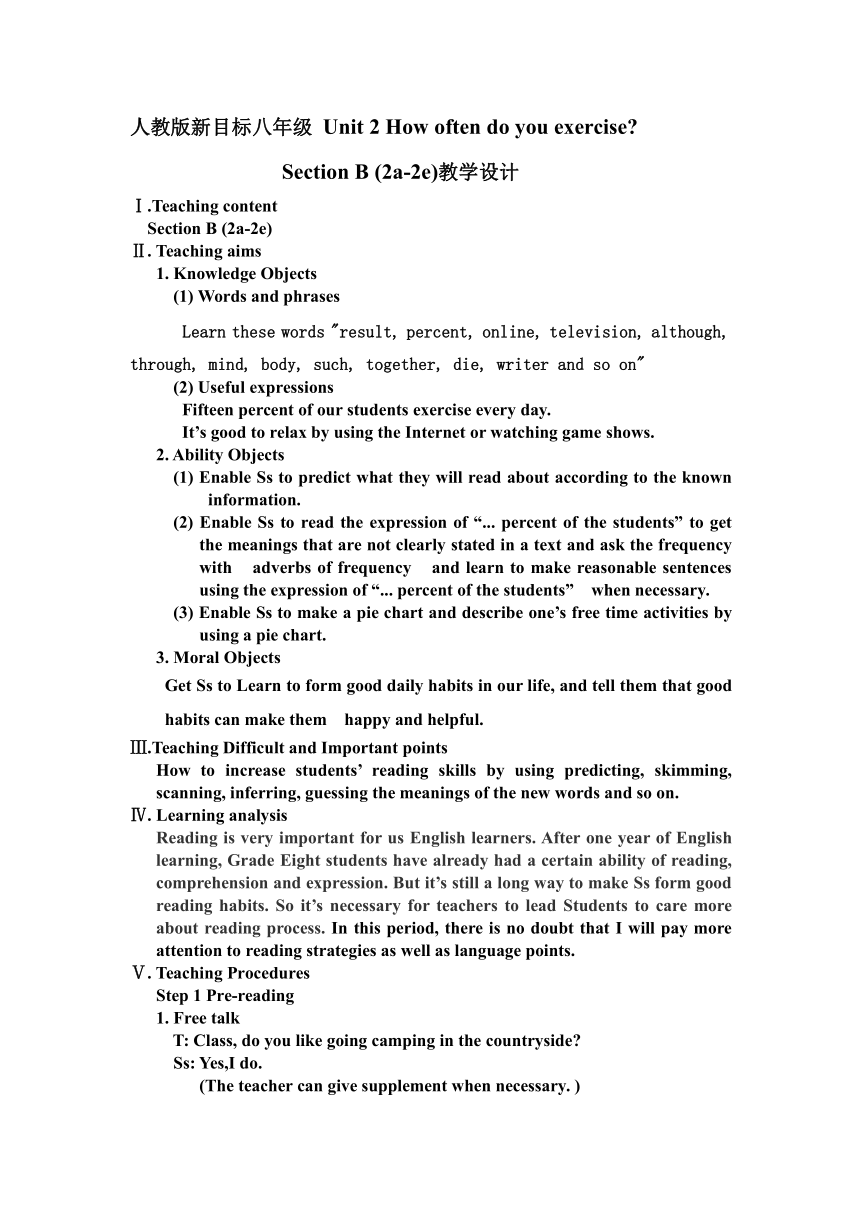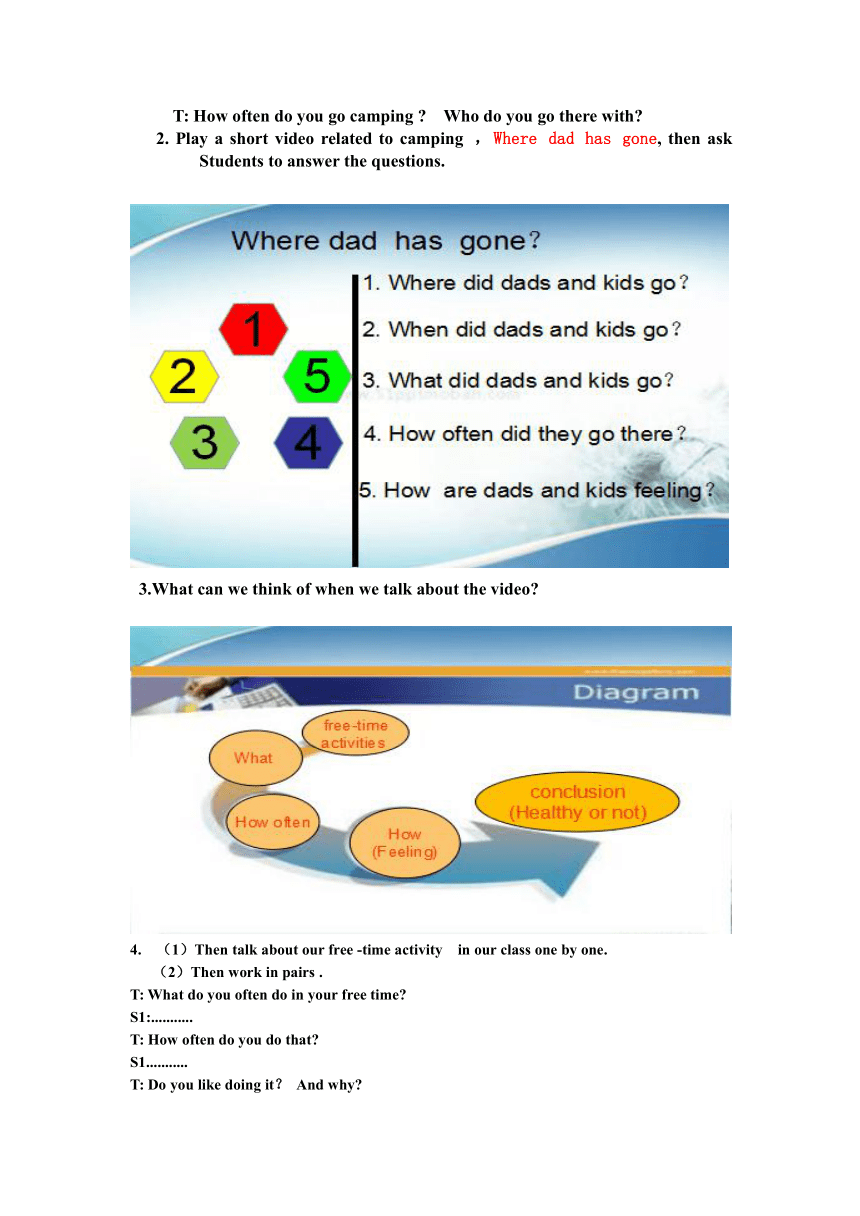人教版八年级上册 Unit 2 How often do you exercise?Section B 2a-2e 教案
文档属性
| 名称 | 人教版八年级上册 Unit 2 How often do you exercise?Section B 2a-2e 教案 |  | |
| 格式 | doc | ||
| 文件大小 | 932.5KB | ||
| 资源类型 | 教案 | ||
| 版本资源 | 人教新目标(Go for it)版 | ||
| 科目 | 英语 | ||
| 更新时间 | 2022-11-06 22:57:03 | ||
图片预览



文档简介
人教版新目标八年级 Unit 2 How often do you exercise
Section B (2a-2e)教学设计
Ⅰ.Teaching content
Section B (2a-2e)
Ⅱ. Teaching aims
1. Knowledge Objects
(1) Words and phrases
Learn these words "result, percent, online, television, although, through, mind, body, such, together, die, writer and so on"
(2) Useful expressions
Fifteen percent of our students exercise every day.
It’s good to relax by using the Internet or watching game shows.
2. Ability Objects
(1) Enable Ss to predict what they will read about according to the known information.
(2) Enable Ss to read the expression of “... percent of the students” to get the meanings that are not clearly stated in a text and ask the frequency with adverbs of frequency and learn to make reasonable sentences using the expression of “... percent of the students” when necessary.
(3) Enable Ss to make a pie chart and describe one’s free time activities by using a pie chart.
3. Moral Objects
Get Ss to Learn to form good daily habits in our life, and tell them that good habits can make them happy and helpful.
Ⅲ.Teaching Difficult and Important points
How to increase students’ reading skills by using predicting, skimming, scanning, inferring, guessing the meanings of the new words and so on.
Ⅳ. Learning analysis
Reading is very important for us English learners. After one year of English learning, Grade Eight students have already had a certain ability of reading, comprehension and expression. But it’s still a long way to make Ss form good reading habits. So it’s necessary for teachers to lead Students to care more about reading process. In this period, there is no doubt that I will pay more attention to reading strategies as well as language points.
Ⅴ. Teaching Procedures
Step 1 Pre-reading
1. Free talk
T: Class, do you like going camping in the countryside
Ss: Yes,I do.
(The teacher can give supplement when necessary. )
T: How often do you go camping Who do you go there with
2. Play a short video related to camping ,Where dad has gone, then ask Students to answer the questions.
3.What can we think of when we talk about the video
4. (1)Then talk about our free -time activity in our class one by one.
(2)Then work in pairs .
T: What do you often do in your free time
S1:...........
T: How often do you do that
S1...........
T: Do you like doing it? And why
5.Design a real situation to teach the new words in the text.
【设计意图】由师生之间的Free talk引入话题业余活动,频率如何,借助视频资源导入本节课的话题—Free-time activity, 进而由Free-time activity引出思维导图,主要为了激活学生已有的背景知识,激发他们的学习兴趣和参与意识,实现“头脑风暴” ,而且还在话题和词汇方面为接下来的阅读做好了铺垫。
Step 2 While -reading
1.Predicting
1). Look at the title and the mind map, try to predict What we will read about Don’t decide if his or her answer is right.
2). Now read the passage quickly and find out if the answer is right. At the same time, try to find the answer to the question: How many kinds of free time activities are mentioned in the passage
【设计意图】通过读标题对文章内容进行预测,可以让学生形成阅读期待他们能够带着兴趣和验证的态度进行阅读;快速阅读的环节则主要为了让学生对文章有个整体了解, 同时训练学生寻读 (scanning) 技巧。
2.Skimming
1). Read the passage very quickly and find:
1. How many passages are there in the article What are they
2.Can you complete the mind-map
y
3.Scanning
1)Read Paragraph2-4 and find out more detailed information about free -time activity,including the name and the frequency of the activity .and then complete the mind-map and the pie chart.
2).Watch another video about foreign students’ free-time activities and then have a competition to understand the differences between Chinese students and foreign students’in groups of three.
3)Read Paragraph 5 of the article and complete the mind-map,Pay more attention to the conclusion:and remember “Old habbits die hard.”So start exercising before it’s too late.
4.Intensive reading
1). Read the passage more carefully and mark True (T) or False ( F).
1. We found that twenty percent of our students exercise every day.()
2. Ninety percent of the students use the Internet every day. ()
3. Most students use the Internet for homework. ()
4. Only twenty percent often students watch TV two or three times a week.()
5. Doing exercise is healthy for the mind and the body. ()
【设计意图】细致的分段阅读,可以帮助学生把握文章的细节信息,正确理解文章内容,同时也有利于对学生在理解上存在的困难进行有效的指导; 而个别具有语境猜测条件的词汇留给学生在阅读中去猜测,训练了学生结合语境猜词的能力。引进竞赛机制,展开对中外业余活动的差异进行讨论,既增强学生的学习积极性,又拓展了学生们的知识视野,从而引导学生多做健康的有益的课外活动。
Step 3 Post-reading
1. Language Points
How many important and difficult language points can you find Read the three paragraphs one by one, and get Ss to find them by themselves. Then the teacher gives some explanations when necessary.
2. Make a survey about one of these free time activities in your group own,then make a pie chart and write a passage.
Read the passage again and fill in the blanks with proper words.
For example:
Hello! Everyone! There are eight students in our group. About thirty-five percent of the students do sports one –three times a week.Fifty percent of the students do sports four to six times a week. Fifteen percent of the students do sports every day. They think that doing sports is good for their health.So Let’s do sports before it’s late.
3. Let’s have a debation :Which free time activity is more healthy?
4.Finally, emotion、attitude and value guide.
The teacher makes a summary statement: After reading the passage, Let’s Load in a healthy ship:we should eat well;drink healthily;sleep well;do sports;
be happy;communicate(交流);study well …… .it’s the secret to our happiness.
【设计意图】“阅读后”是对阅读内容的回顾、深化、拓展和利用阶段,以语言输出为主要活动形式。首先让学生自主探究和发现文章中的语言疑难点,可以激发学生自主学习的能力;然后提供一篇调查让孩子们先画出饼图然后再独立成文,目的在于进一步加深学生对课文的理解,巩固部分重点单词的运用;最后进行辩论是本节课的高潮部分,让学生在理解课文的基础上,展开想象,综合运用所学语言进行适当的语言输出。而情感、态度、价值观的引领应渗透在每节课中,通过潜移默化,能促进学生综合人文素养的提高。
Step5 blackboard Design
PAGE
Section B (2a-2e)教学设计
Ⅰ.Teaching content
Section B (2a-2e)
Ⅱ. Teaching aims
1. Knowledge Objects
(1) Words and phrases
Learn these words "result, percent, online, television, although, through, mind, body, such, together, die, writer and so on"
(2) Useful expressions
Fifteen percent of our students exercise every day.
It’s good to relax by using the Internet or watching game shows.
2. Ability Objects
(1) Enable Ss to predict what they will read about according to the known information.
(2) Enable Ss to read the expression of “... percent of the students” to get the meanings that are not clearly stated in a text and ask the frequency with adverbs of frequency and learn to make reasonable sentences using the expression of “... percent of the students” when necessary.
(3) Enable Ss to make a pie chart and describe one’s free time activities by using a pie chart.
3. Moral Objects
Get Ss to Learn to form good daily habits in our life, and tell them that good habits can make them happy and helpful.
Ⅲ.Teaching Difficult and Important points
How to increase students’ reading skills by using predicting, skimming, scanning, inferring, guessing the meanings of the new words and so on.
Ⅳ. Learning analysis
Reading is very important for us English learners. After one year of English learning, Grade Eight students have already had a certain ability of reading, comprehension and expression. But it’s still a long way to make Ss form good reading habits. So it’s necessary for teachers to lead Students to care more about reading process. In this period, there is no doubt that I will pay more attention to reading strategies as well as language points.
Ⅴ. Teaching Procedures
Step 1 Pre-reading
1. Free talk
T: Class, do you like going camping in the countryside
Ss: Yes,I do.
(The teacher can give supplement when necessary. )
T: How often do you go camping Who do you go there with
2. Play a short video related to camping ,Where dad has gone, then ask Students to answer the questions.
3.What can we think of when we talk about the video
4. (1)Then talk about our free -time activity in our class one by one.
(2)Then work in pairs .
T: What do you often do in your free time
S1:...........
T: How often do you do that
S1...........
T: Do you like doing it? And why
5.Design a real situation to teach the new words in the text.
【设计意图】由师生之间的Free talk引入话题业余活动,频率如何,借助视频资源导入本节课的话题—Free-time activity, 进而由Free-time activity引出思维导图,主要为了激活学生已有的背景知识,激发他们的学习兴趣和参与意识,实现“头脑风暴” ,而且还在话题和词汇方面为接下来的阅读做好了铺垫。
Step 2 While -reading
1.Predicting
1). Look at the title and the mind map, try to predict What we will read about Don’t decide if his or her answer is right.
2). Now read the passage quickly and find out if the answer is right. At the same time, try to find the answer to the question: How many kinds of free time activities are mentioned in the passage
【设计意图】通过读标题对文章内容进行预测,可以让学生形成阅读期待他们能够带着兴趣和验证的态度进行阅读;快速阅读的环节则主要为了让学生对文章有个整体了解, 同时训练学生寻读 (scanning) 技巧。
2.Skimming
1). Read the passage very quickly and find:
1. How many passages are there in the article What are they
2.Can you complete the mind-map
y
3.Scanning
1)Read Paragraph2-4 and find out more detailed information about free -time activity,including the name and the frequency of the activity .and then complete the mind-map and the pie chart.
2).Watch another video about foreign students’ free-time activities and then have a competition to understand the differences between Chinese students and foreign students’in groups of three.
3)Read Paragraph 5 of the article and complete the mind-map,Pay more attention to the conclusion:and remember “Old habbits die hard.”So start exercising before it’s too late.
4.Intensive reading
1). Read the passage more carefully and mark True (T) or False ( F).
1. We found that twenty percent of our students exercise every day.()
2. Ninety percent of the students use the Internet every day. ()
3. Most students use the Internet for homework. ()
4. Only twenty percent often students watch TV two or three times a week.()
5. Doing exercise is healthy for the mind and the body. ()
【设计意图】细致的分段阅读,可以帮助学生把握文章的细节信息,正确理解文章内容,同时也有利于对学生在理解上存在的困难进行有效的指导; 而个别具有语境猜测条件的词汇留给学生在阅读中去猜测,训练了学生结合语境猜词的能力。引进竞赛机制,展开对中外业余活动的差异进行讨论,既增强学生的学习积极性,又拓展了学生们的知识视野,从而引导学生多做健康的有益的课外活动。
Step 3 Post-reading
1. Language Points
How many important and difficult language points can you find Read the three paragraphs one by one, and get Ss to find them by themselves. Then the teacher gives some explanations when necessary.
2. Make a survey about one of these free time activities in your group own,then make a pie chart and write a passage.
Read the passage again and fill in the blanks with proper words.
For example:
Hello! Everyone! There are eight students in our group. About thirty-five percent of the students do sports one –three times a week.Fifty percent of the students do sports four to six times a week. Fifteen percent of the students do sports every day. They think that doing sports is good for their health.So Let’s do sports before it’s late.
3. Let’s have a debation :Which free time activity is more healthy?
4.Finally, emotion、attitude and value guide.
The teacher makes a summary statement: After reading the passage, Let’s Load in a healthy ship:we should eat well;drink healthily;sleep well;do sports;
be happy;communicate(交流);study well …… .it’s the secret to our happiness.
【设计意图】“阅读后”是对阅读内容的回顾、深化、拓展和利用阶段,以语言输出为主要活动形式。首先让学生自主探究和发现文章中的语言疑难点,可以激发学生自主学习的能力;然后提供一篇调查让孩子们先画出饼图然后再独立成文,目的在于进一步加深学生对课文的理解,巩固部分重点单词的运用;最后进行辩论是本节课的高潮部分,让学生在理解课文的基础上,展开想象,综合运用所学语言进行适当的语言输出。而情感、态度、价值观的引领应渗透在每节课中,通过潜移默化,能促进学生综合人文素养的提高。
Step5 blackboard Design
PAGE
同课章节目录
- Unit 1 Where did you go on vacation?
- Section A
- Section B
- Unit 2 How often do you exercise?
- Section A
- Section B
- Unit 3 I'm more outgoing than my sister.
- Section A
- Section B
- Unit 4 What's the best movie theater?
- Section A
- Section B
- Unit 5 Do you want to watch a game show?
- Section A
- Section B
- Unit 6 I'm going to study computer science.
- Section A
- Section B
- Unit 7 Will people have robots?
- Section A
- Section B
- Unit 8 How do you make a banana milk shake?
- Section A
- Section B
- Unit 9 Can you come to my party?
- Section A
- Section B
- Unit 10 If you go to the party, you'll have a grea
- Section A
- Section B
